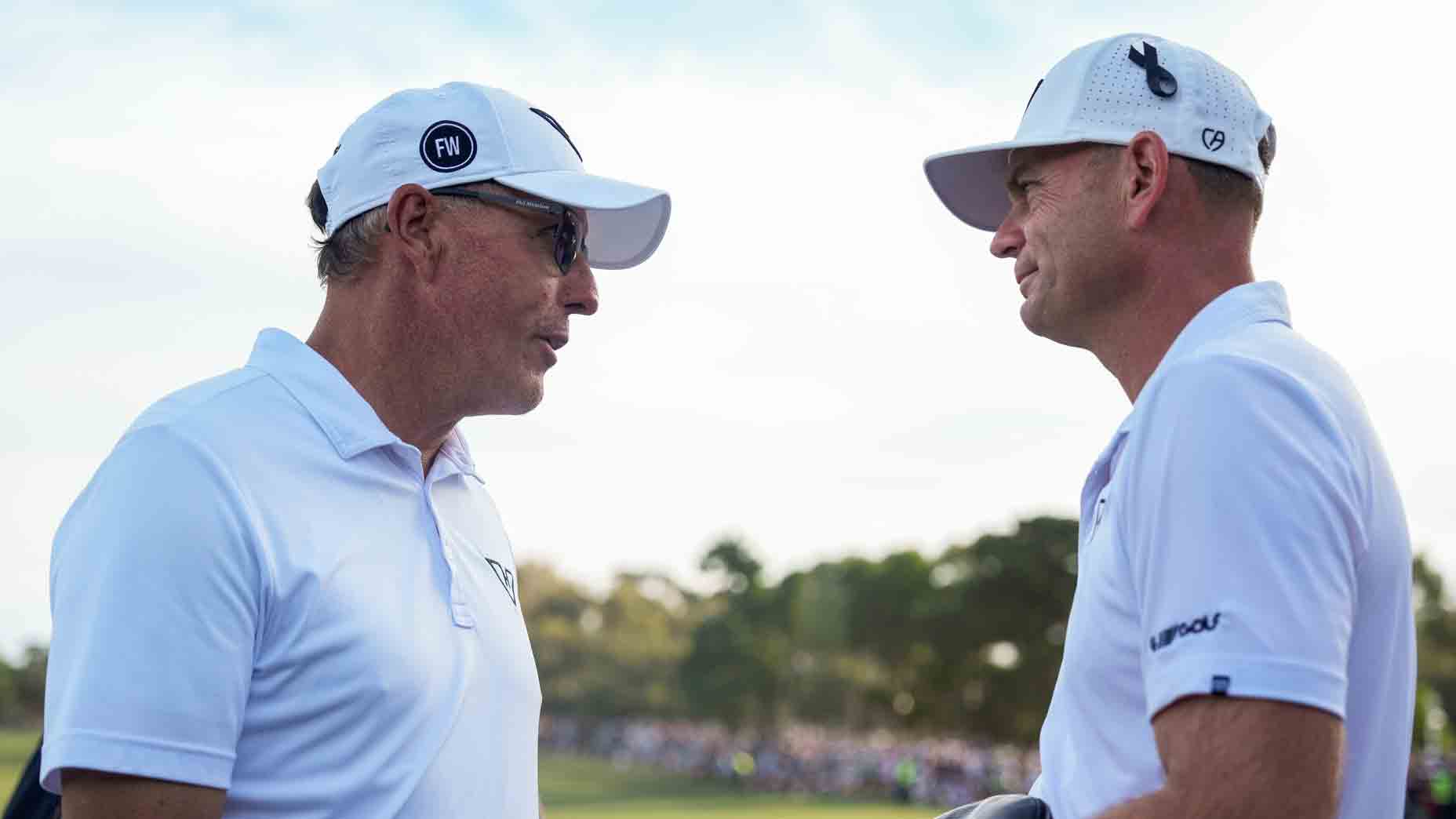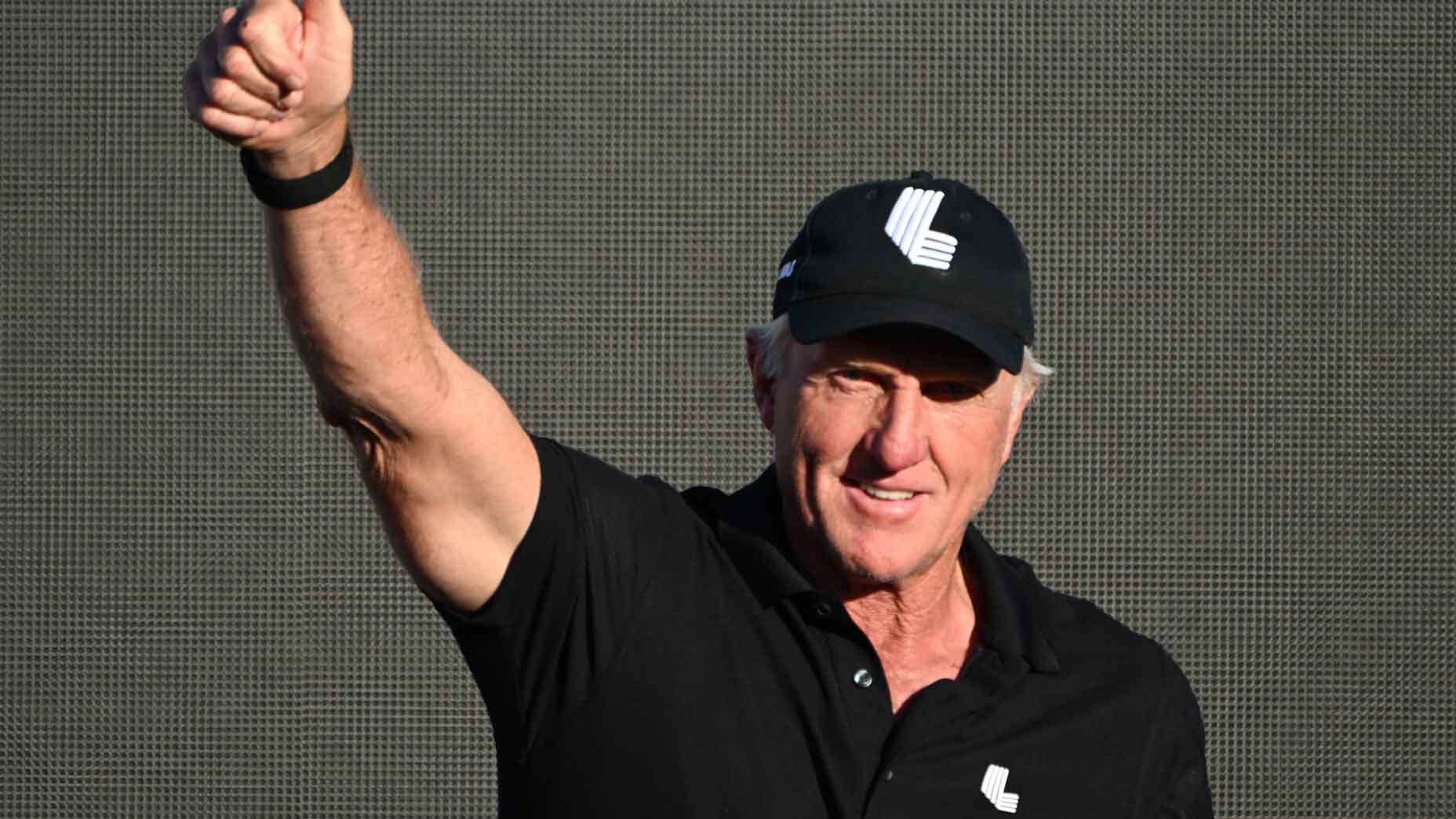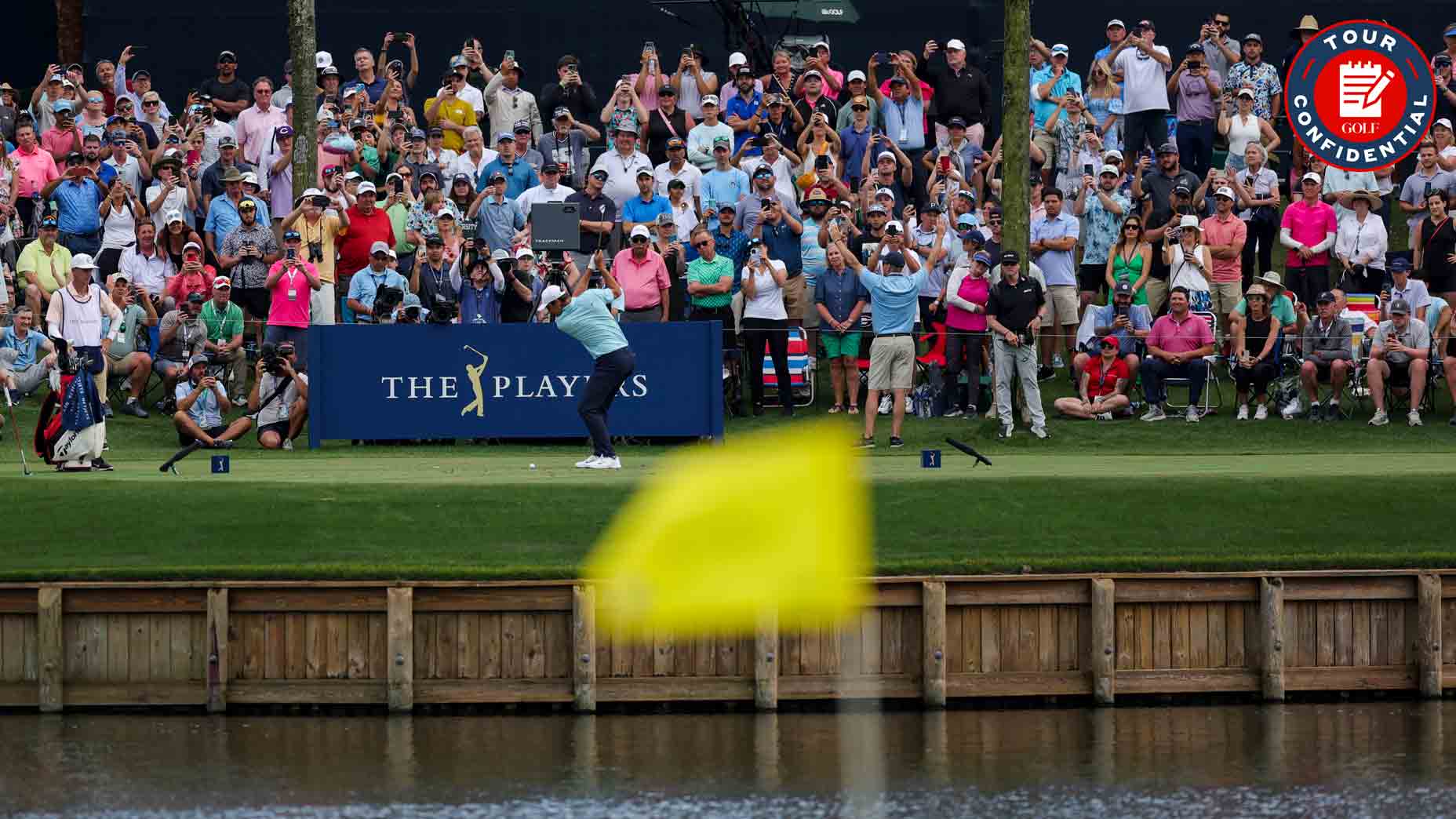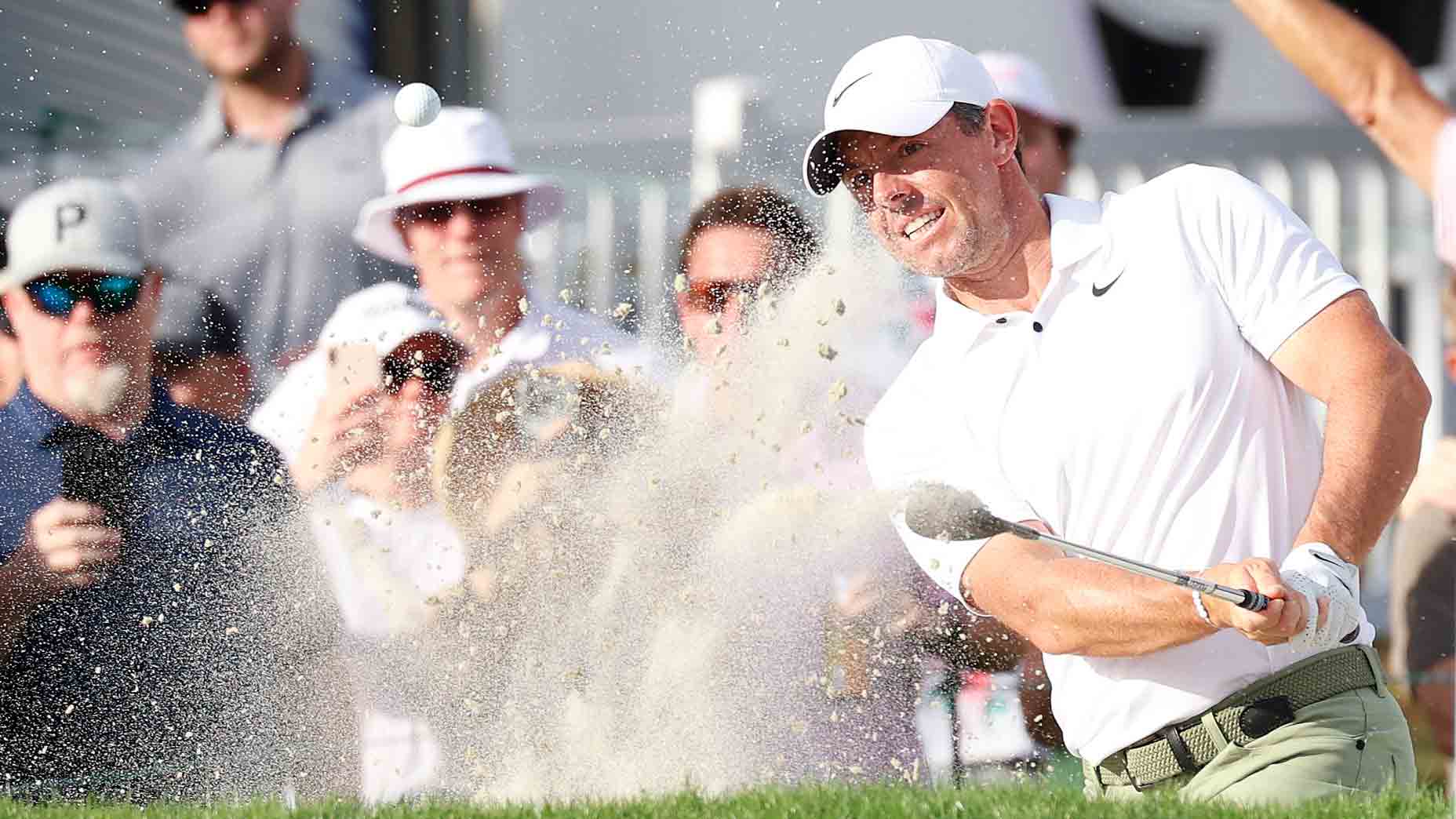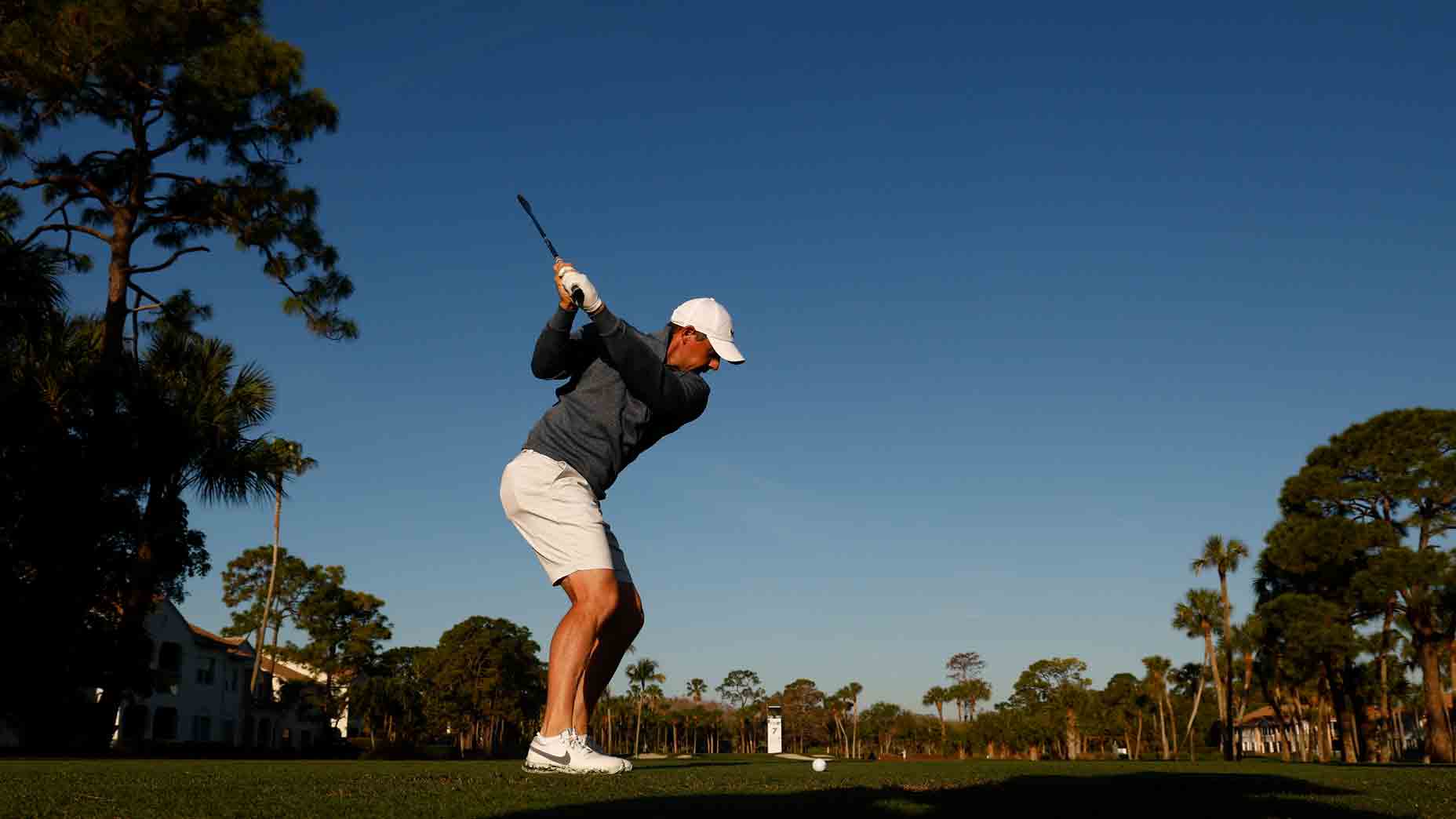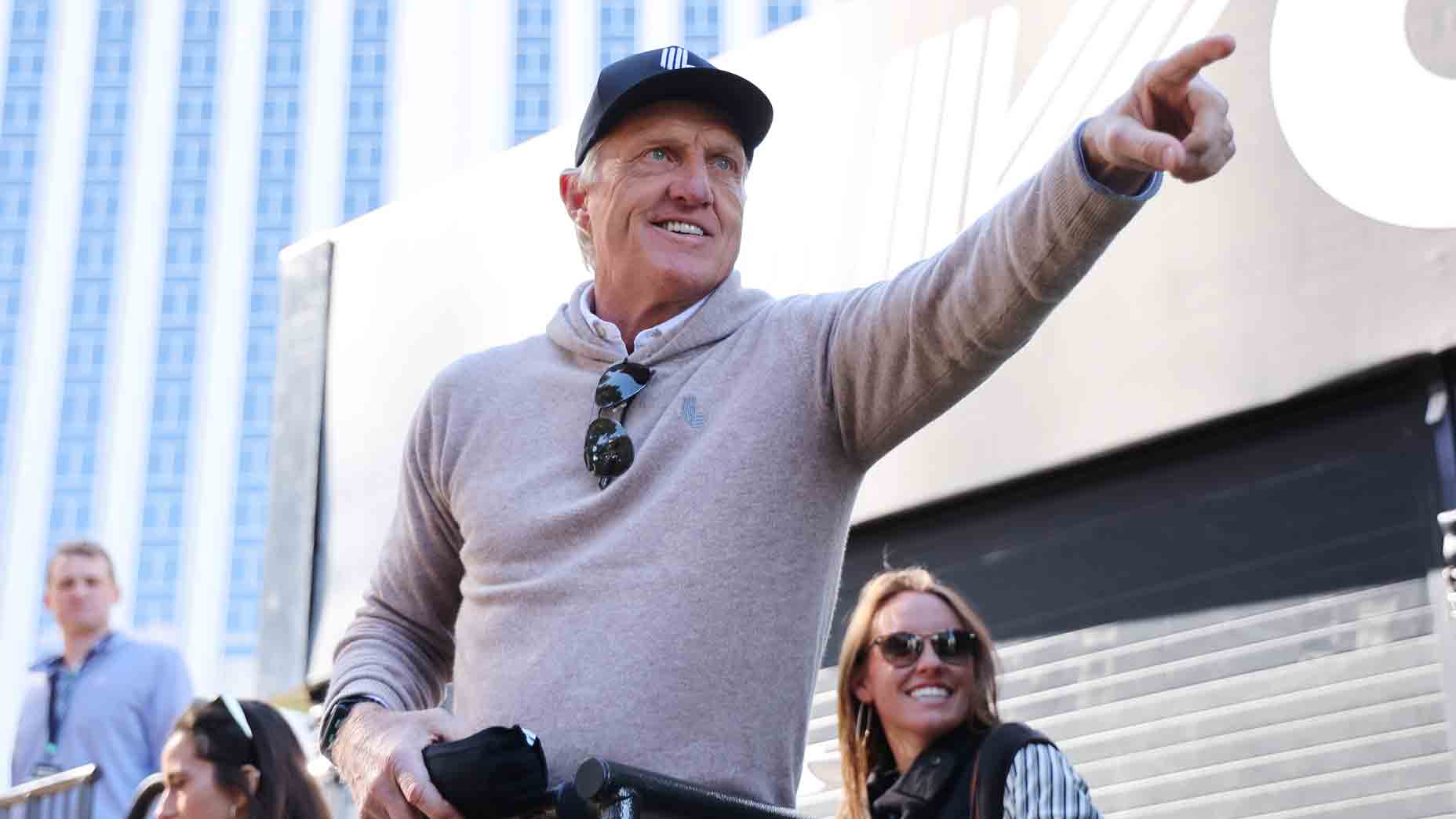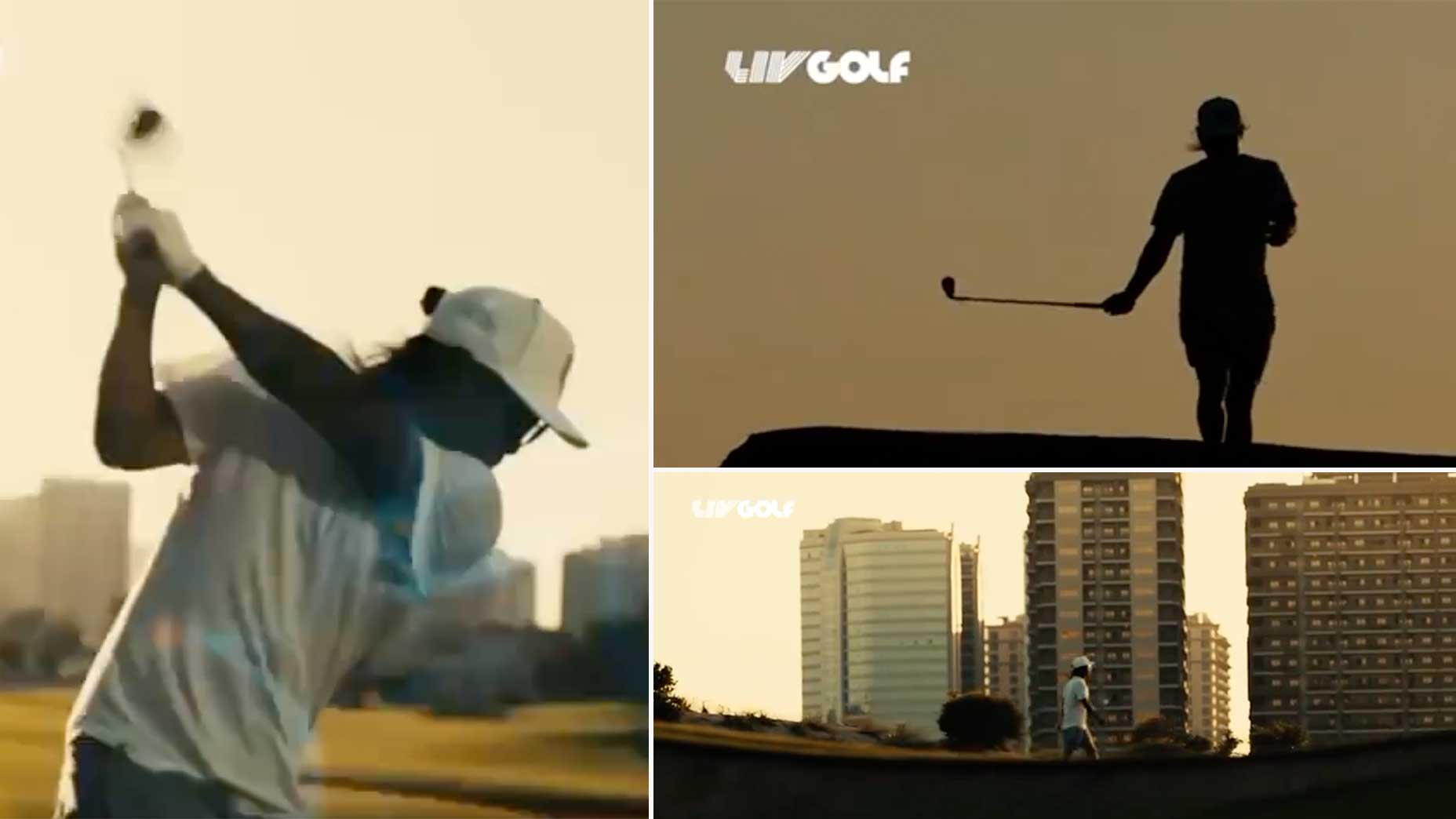I spent 2 years chasing my pro golf dream. Here’s what happened

Dylan Dethier
Author’s note: Hey gang — Dylan Dethier here. This was the first piece I wrote for GOLF Magazine/GOLF.com, all the way back in 2017, when I was a broke freelancer and recovering professional golfer. It remains the longest piece I’ve written for the brand — you’ll see once you start scrolling — and the most personal, too. Because our website’s going through some updates and purging some old material, I wanted to give this one a refresher and make sure it didn’t get lost in the depths of the internet. Hope you enjoy!
****
LET ME START BY SAYING THIS: I’m really, really good at golf.
I can fly it 300 yards off the tee with a tight draw. In 2016 I went a month without shooting a score over par. I share the course record of 63 with Sam Snead at Ontario’s Napanee Golf Club. I can hit a hook that’ll climb over a tree and a slice that’ll skip across a pond, and I can hit a flop shot so high and soft that it lands like a marshmallow. When my putter gets hot, it’s the best part of my game. Of the 60 million players in the world, I’m in the top 10th of the top 10th of the top percent of them. If you lined up 100,000 golfers, I’m guessing I’d be better than at least 99,992 of them.
And in my two-and-a-half years as a professional golfer, I’ve learned two things. The first: I’m basically trash. Plenty of guys can fly it 300 yards, and lots of them can keep it in the fairway more often than me. Everyone can hit that flop shot, and there are guys who are far steadier putters than I am. Although I’ve made a ton of progress from a middling, distinctly unprofessional Division III college career, my tour-ready rounds have remained the exception rather than the rule.
But the second thing I’ve learned complicates matters: In golf, everyone is kind of trash right up until the moment when they’re not. It’s a sport where progress is confusing; in football or basketball, if you’re not on the track to the pros by the time you’re a teen, there’s not much hope for you. But many golfers take roundabout routes to the PGA Tour, which requires playing well at a few very specific tournaments—Q school, in particular—and then cashing in on the opportunities that come thereafter.
What James Hahn told GOLF.com after his first PGA Tour win has always stuck with me, mostly because he doesn’t seem to have any idea what changes took him from mini-tour to millionaire. “Just kind of look at myself in the mirror some days and tell myself that I’m not even supposed to be here,” Hahn said after winning the Northern Trust Open in February 2015. “Come from a small town. Didn’t do well in college. Was never an All-American. Sold shoes for a living for a while. Yeah, and then just one day, the putts started going in and started playing a little better. Won a couple golf tournaments, and now I’m here.”
It’s a remarkable story, if affectless in its retelling. And it fills me with the belief that I could be the next James Hahn; in six months or three years or 11 years, something would click where I’d start getting the ball in the hole in slightly fewer strokes, and fame and fortune would follow. The average Tour pro is 35 years old, after all, so 25 is fairly young to be calling it quits. Many millionaire golfers have taken years to grind through the low-level professional ranks, and many more will follow. But it’s far more likely that chasing the dream for the next decade will get me no closer to the Tour, and that I’ll mortgage my future and be left with nothing to show for it but significant debt and bitterness.
Golf has earned its reputation for elitism and inaccessibility, but the professional game is actually fairly meritocratic in a way that lends itself to dream-chasers. After all, to be a top pro you don’t need to be young, tall, fast, thin or muscular. You don’t have to be able to dunk a basketball or throw a football 40 yards with a flick of the wrist. You don’t need to get drafted to the big leagues or sign with a team. If you can always shoot the lowest score, you’ll make money and move up the ranks, and if you keep shooting the lowest score you’ll be on the PGA Tour. That possibility didn’t mean it was smart to eschew real jobs in favor of turning pro alongside my college teammate and coconspirator, Cody Semmelrock. But it meant we were giving ourselves a chance.
Depending on the day, I look back at my golf career and don’t know whether to be proud of my efforts or weep at my own ineptitude. Golf has a way of pumping you up and breaking you down, often one right after the other. No wonder tour pros develop a relationship with the game that others have with blackjack or opiates. I still love golf, but I know far too many others who have come to hate the game, and what it’s done to them. So I have an announcement: I’m retiring, effective immediately. Touring pro Dylan Dethier, known for his appearance on the All-New England Small College Athletic Conference second team, his T-3 at the one-day West Florida Golf Tour’s Bradenton Series, his ascension to 1,543rd in the World Golf Ranking and his three-month stint as the worst player in the history of the Canadian tour, is officially done. Finished.
But in the wake of my retirement I’d like to add this: I got to live the dream. All my buddies growing up in Williamstown, Mass., dreamed of being professional athletes; it was pretty cool to take the leap and actually do it. For two years, I lived with all the fears, successes, failures, pressures and adventure of an aspiring pro. I believed I was close to making it to the next level, all the while teetering on the edge of poverty and despair.
***
IN THAT FIRST CAREFREE SUMMER of 2014, following my graduation from Williams College (where I’d nabbed an English degree), my days all ended the same way: fending off mosquitos, dripping sweat and chasing a faraway vision in the fading light of the early evening. My new home was North Conway, a small tourist town in northern New Hampshire where the golf course was long on scenery if short on maintenance budget. The fairways and greens had only spotty grass, decimated by an icy winter and a late thaw, but no matter — my game was equally unpolished. I spent the mornings working on small projects as a caretaker of my cousins’ house, and in the afternoons I’d head to the course, searching for my future in the dirt.
North Conway was where I came to turn the 77s that meant success at a Division III college program into the 67s I’d need to stay afloat on any pro circuit. It was a far cry from the walled-off fairways and manicured practice areas of Jupiter, Fla., where Tour players (theoretically my competition) honed their lucrative craft. But New England was where I was most comfortable, at a friendly public course that lacked any of the extra crap — the uptight snobbery and trappings of clubby exclusivity — that can get in the way of playing golf, which on its own is a nearly perfect game.
One of the first steps to better golf would be to tame the search-and-rescue style of play that I’d developed in high school and college. My driver betrayed me often enough that I’d developed a wicked short game, and I derived real pleasure from slicing one through the trees or hacking out of a pond, recovery attempts that would lead either to pars or tragedies. On the occasions that I was rewarded with birdie putts, I attacked them with ferocity; I converted quite a few out of desperation and determination. All in all, I was able to duct-tape the holes in my game adequately enough to hang with my collegiate competition, but neither cockiness nor cleverness would be enough to survive against the relentless low numbers being posted on the professional circuits. Still, I hit it far, and I could chip and putt skillfully, and I hoped that my ability to score better than I swung meant untapped potential.
Every day for months, I hit hundreds of range balls to rein in my misses, hundreds of chips and putts so the club would feel like a natural extension of my hands. With every session I told myself to be patient, even stoic. I wasn’t going to be considerably better every day than I had been the day before, but when I looked at the big picture, I realized that even weeks into the process, I’d already made appreciable gains.
On quiet days at the range I could leave my headphones in the golf bag and blast music or podcasts at full volume. I’d haul the water bucket and the bench over to my station, monopolizing the comforts of the spartan setup. Nobody seemed to mind me making myself at home, and I appreciated this anonymity, mostly to avoid having to answer the question of what I did for a living. I didn’t have a job because my job, I’d decided, should be golf. Can you call yourself an artist before you’ve created any art?
***
THE FIRST TIME I thought I was getting pretty good at golf came after the first round of the 2014 Providence Open, where I was making my professional debut. Providence is one in a series of small-time tournaments around New England, events that run from June through August, and even though the winners don’t make more than a few thousand dollars, the competition is stiff.
I was nervous, eager to show myself that all the preparation could already pay off in competition. I called in my lifelong friend Taylor Foehl to caddie, and we drew a lucky break by being paired for the first round with Cody, who’d been practicing from his Connecticut home since graduation. I’d played dozens of rounds with Cody over the previous four years, and I’d play dozens more in the year to come, but something was different as I stepped to this 1st tee that made me suddenly more aware of my heartbeat. I’d learned as a kid that feigning confidence provided me with something like actual confidence, so I nonchalantly teed up a Williams College-stamped Titleist, a remnant of my dwindling supply. I stuck to my lifelong 1st-tee pre-shot routine by taking two cartoonishly hard swings to shake the cobwebs from my back and brain, but it didn’t quite work—I hit a hard hook and watched in panic as my ball tumbled toward the O.B. fence, certainly a bad omen for a fledgling career.
We watched in silence as it hopped once, twice, thrice, before a merciful tree branch jumped into its path, bringing it safely to rest. I exhaled, relieved that I wouldn’t have to reload after my very first swing as a professional. Instead of staring down double bogey, I followed with a low, hooking 8-iron from the trees that scampered onto the front of the green, and I rolled in the 15-footer. Birdie to start! I rode the wave of good fortune through much of the round. Triggs Memorial was a short, relatively easy course, but it took real golf to make five birdies in my first nine holes, and the 68 I posted was candidly the best round of my life to date. I was tied for fourth place, halfway through the 36-hole event.
Maybe this isn’t so hard, I thought as I lay in bed that night. That would prove to be a dumb thought.
On the morning of the second round, I studied my competition in earnest on the putting green, glancing around at the mix of talented regional amateurs and pros, curious who they were. The tournament had a gritty feel. I judged most of the pros to be in their 20s, although two precocious junior players and a handful of leathery-faced men of ambiguously advanced age were also high on the leader board. A half-dozen fresh-faced kids, either still enrolled or recently graduated, broadcast their collegiate affiliations by way of shirt, pants, hat and golf bag. A couple even had their school mascot stamped onto their shoes. Two sharper pros had the head-to-toe dress of sponsored golfers — one in Nike, the other in TaylorMade — but a majority of the crowd sported the endorsement look only to be betrayed by the incongruity of, say, a Callaway shirt and a Titleist hat. I’d chosen a Hartford Whalers baseball cap and a pair of blue trousers that had neither the sheen nor the flexibility of the polyester golf-specific khakis of my better-outfitted opponents.
I went off in the penultimate pairing with a junior from UConn and a recent Yale grad, two young smashers. Whether it was nerves or simply a regression to my mean, I never regained the groove I’d found in the first round. I made some nifty par saves and battled all day to stay in contention, but I watched more birdies than bogeys from my playing partners and could tell that the field was pulling away. On the 17th hole, sitting at even par for the day, I stared down a short putt with real consequences: If I made it, I would move into the top 10, in position to earn around $700 — a pretty healthy first paycheck and a respectable return on my $400 entry fee. Unfortunately, only the top 10 pros would get paid, so if I missed the putt, I’d get skunked. I can get a little stiff over meaningful putts; my left elbow freezes up and I leave the face open a few degrees. I didn’t know this at the time, or else maybe I could have prevented what happened. I took a little too long over the ball, and sure enough it shot off the putter blade some two inches to the right of my target, tickling the outside lip but remaining rudely above ground. A routine par at the last cemented my fate. Despite my strong opening round, my play had earned me nothing.
As we climbed into the car for the drive home, Taylor paused for a second before turning the key. “That was really fun, and I think you’ve gotten a lot better already,” he told me. “But if you’re still playing the Providence Open in three years, I’m gonna break every one of your clubs myself.”
****
TWELVE DAYS LATER, as my group waited to tee off on the 12th hole at Bangor Municipal in northern Maine, I thumped the ground with my driver, stewing over the mediocre chip shot that had yielded bogey at the previous hole. We were waiting for a golfer to reappear from the woods and claim his bag in the left rough, but he’d been in there for several minutes. I felt a twinge of sympathy for him, as there were only two possibilities: He was looking in vain for his ball and was going to have to return to the tee; or he’d found it somewhere in the thicket between the fairway and Interstate 95 and was having trouble figuring out how to extract himself. I tried to push aside the other petty feeling I had: the satisfaction that he was struggling and would be tumbling down the leader board.
The Greater Bangor Open has been contested since 1967 and had perhaps peaked in 1971 when Lanny Wadkins collected the $600 first prize, just a year before he’d be named PGA Tour Rookie of the Year. Wadkins is now too old to compete on the Champions tour; the Greater Bangor Open, the self-described “Best Tournament in New England,” was showing its age too, a shabby, beloved event on an outdated muni course in a sagging town that has never recovered from the decimation of the state’s once-prodigious lumber industry. But professional golfers have a gambler’s mentality when it comes to entering tournaments, and even though it meant a long trip to Bangor, there was just enough cash and competition available to attract players from Florida, Kentucky, the Carolinas and Ontario. Most would move on to the Maine Open and the New Hampshire Open the following week.
As we waited on the tee, I noticed the particular way that one of my playing partners seemed to be staring at exactly nothing, his eyes focused on a spot of air about three feet in front of his face. He stood motionless, seemingly unfazed by the wait. Peter had played the whole day in slow, focused autopilot. His game was joyless and he was inscrutable, except when he hit a bad shot, and then he seemed like he might just about combust, like a computer short-circuiting. I played with a lot of Peters over the next couple of years. Golf zombies, Cody and I called them, guys with an emotional binary system: stoic or enraged.
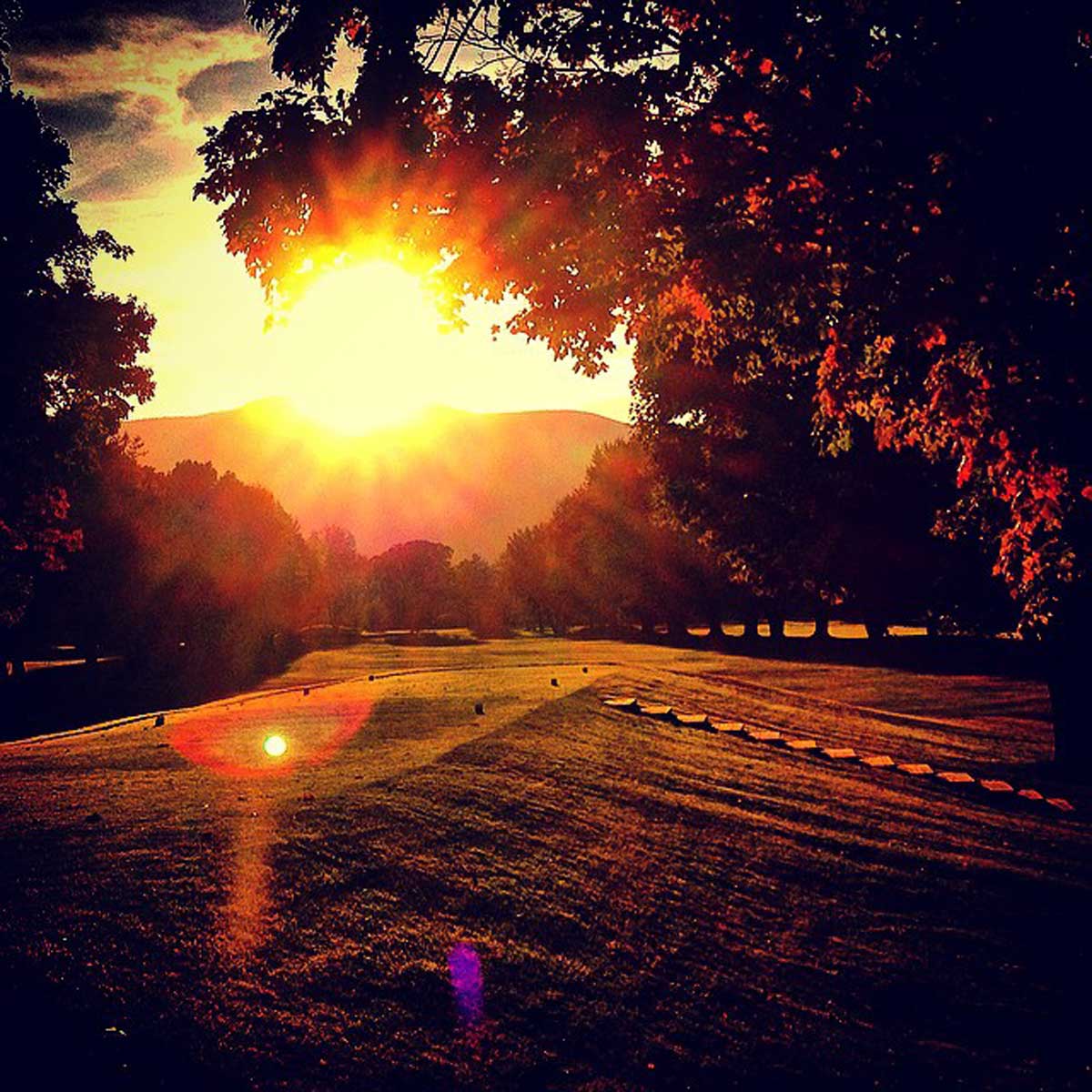
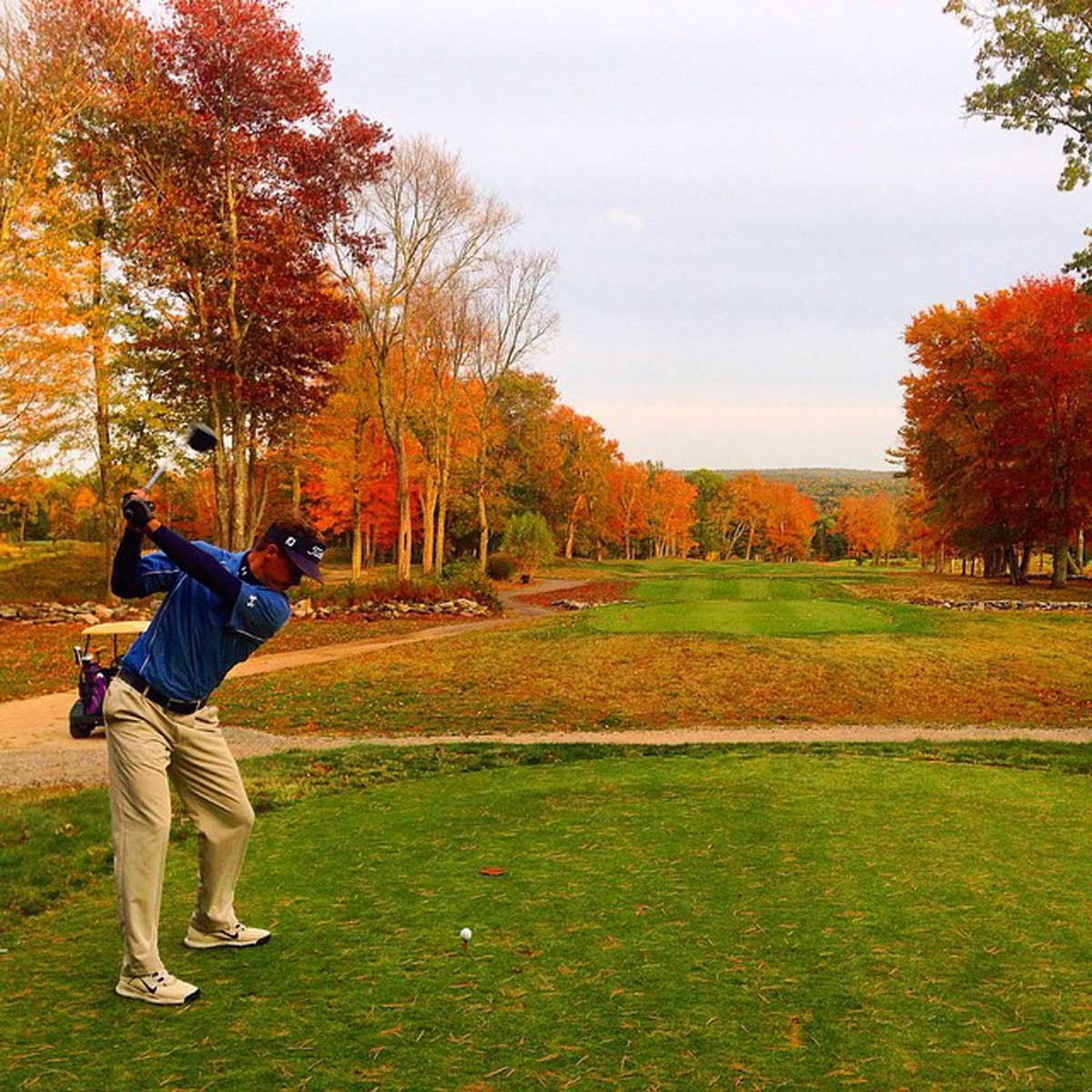
At last the player emerged from the left woods and strode toward the green. I’d spent too much time thinking about where he’d been and wondering how close he’d been to the highway, so I overcompensated by slicing one into the right woods. Lucky to find my ball, I escaped with a bogey. The rest of the round went along smoothly, all pars and a birdie, until I hit a draw instead of a cut off the 18th tee and watched my ball scamper out of bounds, leading to a double bogey in front of a handful of elderly fans and a news camera that shared a single bleacher behind the green. The double soured my day’s work and took me to one over par, which wouldn’t be keeping up with the sticks at the top of the field.
It was a sweltering afternoon, and after Cody finished off a two-under-par round we headed toward the putting green. Tables had been set up for our free lobster dinner and were already crowded with Titleist-hatted bros. Another player emerged from the clubhouse. I recognized his bag — this was the guy who’d caused our wait.
“Hey Jimmy,” someone yelled,” I saw you stuck in the out-of-bounds on 12. What’d you make there?”
“Oh, 12 — I made par from the center of the fairway,” Jimmy deadpanned. “Only problem was I had vicious diarrhea and had to s— in the trees. Some bad seafood or something last night. I think people were watching me from the highway, but it came on out of nowhere. Brutal. My towel is still out there and that thing… oof, I hope nobody picks it up.”
The whole group cracked up, cringe-laughing.
“What’d you shoot?”
“62,” Jimmy said, betraying no emotion.
I knew it then: I had a long way to go.
***
THAT WINTER, Cody and I packed up our clubs and moved to the soulless municipality of Bradenton, Fla., to train. The notion of living where people come to vacation was appealing on some level, but besides the beach and the donut shop I hated the place. We took up residence in a particularly tough corner of town so we could afford to play at the country club, splitting our days between the stark and the swanky. Just outside our front door, prostitutes paced the sidewalks of Route 41, an endless plasticky strip mall where every block offered some version of fast-food joint, gas station, furniture store, flea market, sports bar. Everything was a chain, with the exception of Da Vinci’s, the strip club just down the block. I hated most of the golf courses in Florida too: the condominiums crowding the edges of every fairway, the man-made lakes, the way the freaking grass grew sideways. I hated most of the members at our club, who always claimed so many strokes that I lost money to them in our Friday games no matter what I shot. Most of all, I hated how at every West Florida Golf Tour event the scores were always lower than I expected, and how I remained incapable of going low enough to contend.
That’s not to say that our Bradenton lifestyle was unappealing. We befriended several other aspiring pros at the club and could always scare up a money game, a chipping contest or some swing advice; as far as workdays go, ours were tough to beat. It felt like a huge advantage to have Cody there too. So many of our peers seemed profoundly unattached to anything beyond their daily routines, living alone and practicing alone in ostensibly joyless existences. That didn’t seem like the dream. It felt imperative to have someone on your side. Cody and I spent most of our waking hours together, going to our daily destinations of gym and golf course, plus the occasional afternoon trip to the beach. We played in nearly all of the same tournaments and got in at least 18 holes on most practice days. I dominated our daily putting contests, but Cody was such a superior ball-striker that he beat me on the course more often than I beat him. We were a pretty formidable money-match team, and on particularly good days would bring home some extra cash to go toward groceries or beer.
I spent much of that winter retooling my swing, trying to break it down into its component parts and piece it back together into a more effective version of itself. I’d grown up with a loopy move where I took the club back relatively far from my body, on an outside track, and dropped my hands in close to my body on the downswing, snapping them from right to left through impact to square the face. This meant that my natural shot would start out well right of my target and (hopefully) hook back toward it. For stretches of my life, when I had just the right timing, it had been an extremely effective way to play, as mid-flight my Titleist would snap back toward the fairway like a well-tossed bowling ball breaks from the right rail toward the headpin. In Florida, though, I was seeking a more neutral, repeatable ball flight that would simplify my game and stand up under pressure. Some days I felt like I was making real progress. Other days, stuck with too many competing thoughts in my head, I’d show up at the range and feel as if I was starting from scratch.
Finally, after months of this drudgery, a bright spot came in the form of an 18-hole tournament at Bradenton Country Club. I birdied the 1st and 4th holes, and for the first time since Cody and I had been down there, I felt a rush of confidence that I was a relevant participant in a golf tournament. I bogeyed the 7th hole but gained momentum at the turn and birdied 10, 11, 13 and 15 to get to five under par. I was playing aggressively, and the putter felt good in my hands. My only tentative moment came on the 18th tee, a long par-3 with out of bounds to the right and long of the green. I was still stuck between playing the hard hook of my youth versus the high cut of my dreams, and I got stuck between these thoughts, aiming directly at the flag but hitting the hook anyway. My ball settled in the rough left of the green, and I made bogey to shoot a four-under 67.
I was kicking myself when I saw the top of the leaderboard: Two were tied at five under, and it stayed that way the rest of the afternoon. Cody was a couple of groups behind me, and he came off the course looking pleased — he also had come in with 67. Were I a more respectable competitor, I’d have spent much more time being pissed about not winning rather than being excited about a share of third place in a one-day West Florida Golf Tour event. But these were the moments I was playing for, living for, the moments where I could take a deep breath and say that I was truly satisfied with something I had accomplished. The fact that Cody and I had both played well was great for roommate morale.
I sat for a while with Cody and Christian Bartolacci, the head of the WFGT, with our feet kicked up in a golf cart parked by the scoreboard as the final groups came in. It shouldn’t have been a big deal, but I couldn’t stop grinning. So much of the weirdness I’d been feeling centered around being an imposter, and here was a sign that I wasn’t completely wasting my time after all. Christian had lived the mini-tour dream himself, and I mentioned to him how relieved I was to finally play a good round.
“There’s a couple of you every day,” he told us. “I wish everyone could adjust their expectations a little, to take the good and the bad in stride.” Christian shook his head. “It used to get to me. I’d bust my ass to get everything set up perfectly: the right signs, a nice course, a fair payout. But everyone would come back miserable. And I would say, ‘What’s wrong with me?’ Now all I can do is laugh at it. Today we played in perfect sunshine, with a big field, on a good course, average pace of play was three hours, 40 minutes, and sure enough Tim comes in howling because he caught a mud ball on number eight.”
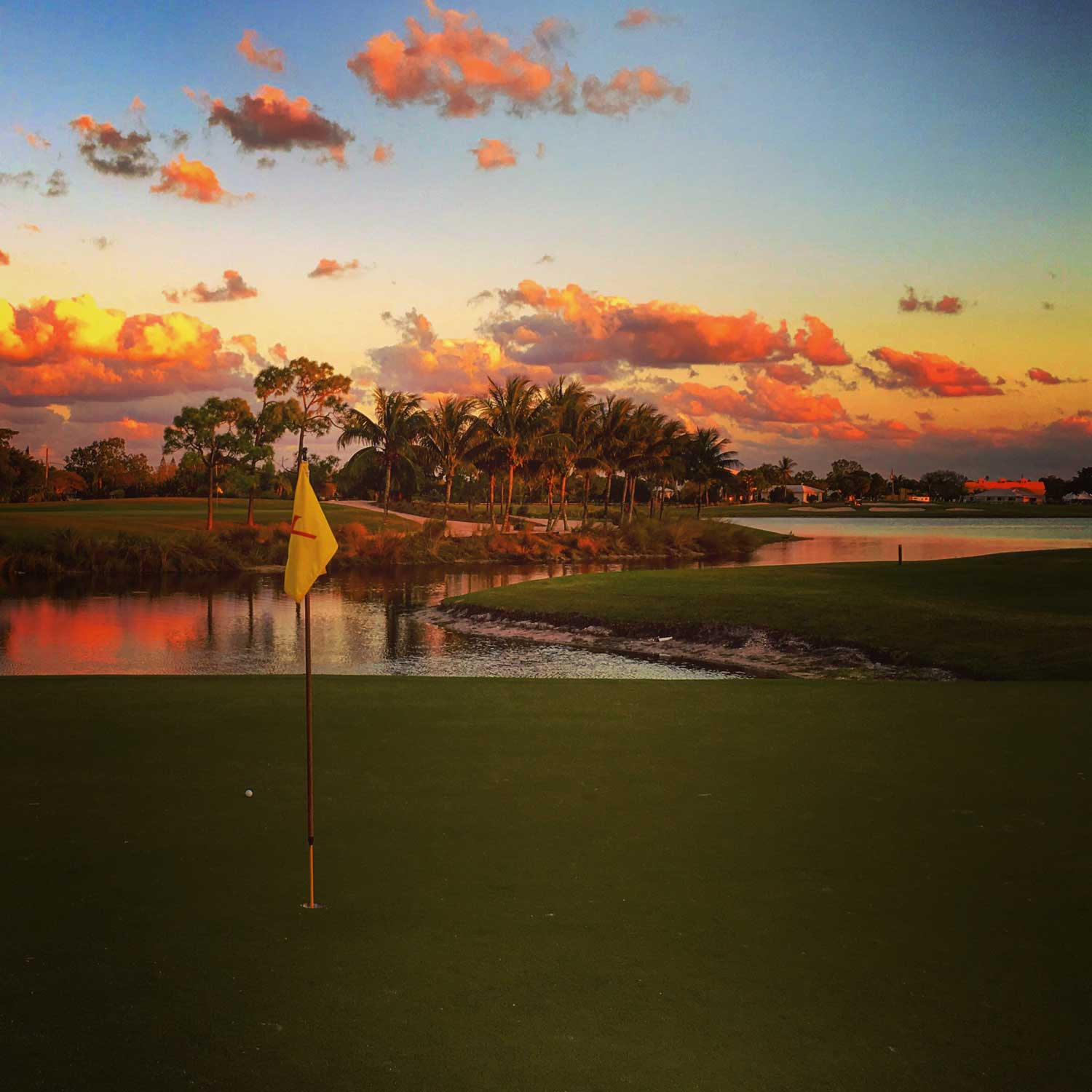
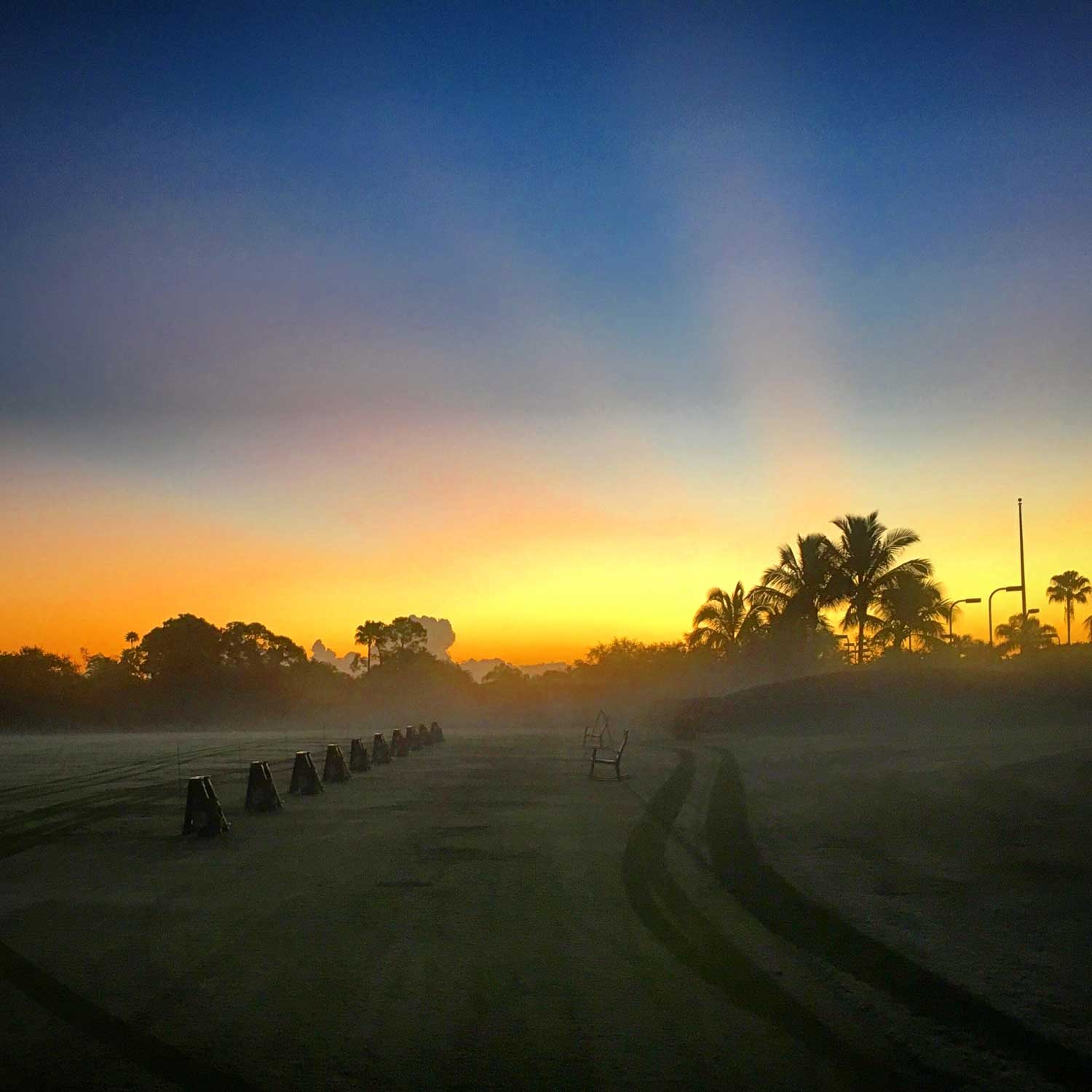
He was right. Everything — bank accounts, happiness, confidence, tournament schedule—was directly correlated to our scores. I consciously tried to stay level, not to get too high when things seemed smooth or too low when everything was tougher. But when you’re playing the West Florida Golf tour, you’d better feel like you’re making some progress so that you don’t have to keep playing it for much longer. To be a low-level professional golfer is to want to be a higher-level professional golfer, which means by definition that nobody on the mini-tours is content being there. There were also the cut-throat dynamics of the mini-tours: We weren’t playing for sponsor money, ticket revenue or merchandise profits; we were playing for cash that came straight out of the pockets of our competitors, and in general none of us had a whole lot to spare. WFGT events typically cost between $200 and $600 to enter, while higher-stakes mini-tour events had buy-ins of up to $1,500. No matter the scale, you were gambling on yourself, hoping to recoup your own money — and take someone else’s.
While tournaments within a day’s drive of our apartment were cheap enough, the expenses for travel and entry fees alone could climb to four figures any week we were on the road, and only a top finish would guarantee a break-even result. Some players picked up side jobs as caddies or bartenders, but most still needed extra help. Some held fundraisers at their country club, while others hit up wealthy family members. A few sold shares of future earnings to investors. (Note to potential buyers: This is a terrible investment.) Money was earned and spent in dramatically different ways. Some players employed swing coaches, strength coaches and sports psychologists, while others of equal ability sold weed to cover their entry fees. Either way, I figured you need something like $50,000 to have the opportunity to struggle and improve over a couple of years. This doesn’t mean that mini-tour players are rich—far more are broke—but professional golf survival skews toward those with big-time backgrounds or generous connections (which is a class and race and problem so meaty that it deserves its own piece). Bottom line: Money dictates opportunity everywhere in professional golf.
Before I enrolled in college I spent a year exploring the United States, hoping to learn more about the country through the game. I lived out of my car, played a course in every state and wrote a book about the experience called 18 in America. (Shameless plug: books still available here!). It did well enough that when I turned pro I had $30k in the bank. Cody, my co-captain at Williams, held a tournament (with dinner and a raffle!) in his hometown to pay for the trip south. We also reached out to former members of the golf team, and a small group of alumni was kind enough to stake us with entry fees for our first six months. As lucky as Cody and I were, we were shorter on resources than most of our peers.
We had paid $200 each to play in the Bradenton shootout. Cody and I got matching third-place checks, worth $412. It wasn’t much, but for one afternoon, we belonged.
****
I’D BEEN A PRO FOR LESS THAN A YEAR when I’d already decided that the worst fate of all would be an aging player stuck in the limbo between breaking through and going broke. Such purgatory would be far worse than simple failure. The mini-tours were filled with these guys: embattled, embittered players with remarkable ability but lacking the certain something that propelled others to the next level.
I turned 23 during that first winter in Florida. Cody and I were among the youngest players on the scene, but there was something discomfiting about the way the days disappeared one after the next, sunny and indistinguishable. I began to fear the passage of time above all else. Some days, the loop of Florida living could feel like paradise, particularly the parts of my routine — having the chipping green to myself on a quiet morning, going for runs along an especially swimmable section of the Gulf of Mexico, playing until I couldn’t see in the warm, still evenings — that felt like I was working toward a goal. But bad days felt regressive, as though time and effort was somehow making me worse. I started having strange, dystopian dreams about Bradenton, dreams in which the entire world was one big golf course inside one big gated retirement community, and if I left its gates I’d turn onto a road where I hit red lights at every intersection for eternity as I passed along a never-ending strip mall.
Double bogeys began to plague my scorecard; big mistakes would send solid tournament rounds into the irrelevance of over-par. All around me, I watched as the game broke people. I played with a 19-year-old who’d dropped out of college the week before and may have been second-guessing his new glamorous lifestyle as he chunked a chip and chucked his sand wedge over my head, the club traveling the better part of a football field before landing in a bush. Another guy missed a par putt on the first hole of a two-day tournament, tapped in for bogey and didn’t even bother to pick up his ball out of the hole — he was so upset with himself that he headed straight to the parking lot. More dispiriting still was my playing partner whose approach shot on the ninth hole of another event got a bad bounce off a rock and into the water. Nearly in tears, he apologized for occupying the same golf course as the rest of the field. “I’m sorry,” he said. “I don’t belong out here. I don’t belong anywhere.”
My girlfriend, Emily, had started a job in New York, and I grew to cherish our evening FaceTime sessions not just for the time we’d spend recounting our new lives but also for keeping me connected to the world that existed beyond my day’s golf score. She cared how I played because I cared how I played, but our occasional weekend meet-ups refreshed me and allowed me to see my own world from the outside, reminders of just how good things were.
Not everyone was so lucky, and the toughest casualty to cope with came from within our inner circle. We’d grown close with a kid I’ll call Mason, an intensely friendly 24-year-old from Miami with a Cheshire cat smile who’d moved to Bradenton a few months before Cody and me. But everything about Mason changed when he lost the ability to chip.
It’s confounding to try to explain the yips, or how an athletic kid with hand-eye coordination like Mason suddenly couldn’t find the face of his wedges. But something had become fundamentally broken. The more Mason worked at it, the worse the problem got. Occasionally he’d perk up, believing he’d solved the problem, but then he’d shank another one and go completely dark with rage. Trouble clouded his eyes. One afternoon, after he chunked a bunker shot at the 16th hole, he snapped his wedge over his knee, expressionless. He zipped the two pieces into a side pocket of his bag and didn’t say a word for the final two holes.
The following week, Cody and I played a match with Mason and his roommate: $10 apiece for nine holes. It was friendly, low stakes, low-key. But he shanked a chip midway through the round, and when we won on the 8th green, Mason put his fist through the windshield of the golf cart, accomplishing a feat I thought impossible. Word came in the next day: He was quitting. He couldn’t take the madness of living in his game for even one more day. One of the members at our club had offered to pick him up for a few sales calls, and Mason jumped at the chance to have a normal life.
Cody and I experienced our own morose mood swings as the money went out a lot faster than it was coming in. I watched Cody struggle with the same pressures I felt: pressure to perform for his family, to have something to show the folks who’d supported him from his hometown, and especially to live up to the pressure he felt from within. That turmoil between expectations and reality lived in all of us. The stories poured in every time I played with someone new, including fistfights in a playoff and emotional breakdowns in the parking lot. There were cautionary tales too: tournaments that were Ponzi schemes set up by scam artists who fled the country without paying their field. It sometimes felt as if we were on a road that led not just to poverty but also to a skeptical, cynical, nihilistic worldview where all that mattered was what you were going to shoot the next day. Everyone was clear about this much: If you got any kind of prize-money check, cash it before it had the chance to bounce. This was not the glamorous life I had imagined.
A few weeks after he went missing, Mason reappeared on the range. He wore a sheepish smile and was clearly happy to be back out in the sun. I asked him what had changed his mind. He answered like it was obvious: “How could I give up on this?”
***
ON APRIL 22, 2015, one swing stood between me and PGA Tour Canada. For 71 holes I had been grinding at the tour’s qualifying tournament, one of 132 dreamers who had put up $2,750 to enter a tournament that awarded no prize money, only opportunity: finishing in the top 40 would guarantee at least partial status on the Canadian circuit. Battering winds and a brutish course had sent scores sky-high, so I knew that even at nine over par I was in line for my tour card. But the 18th hole at La Purisima Golf Course in Lompoc, Calif., was a steeply downhill par-3, and the wind was howling. I’d have given anything just to hit the green, knowing that one bad swing and a buried lie in the bunker would put my career breakthrough on hold.
We waited for a short time for the green to clear, so I calmed my nerves by peeing in a bush behind the tee, one of the perks of having no gallery around. When I returned my college teammate and caddie for the week, Matt McCarron, had already paced off the distance. With wind, slope and adrenaline on my side, we both knew it would play much shorter than the measured 201 yards.
“Should just be a good 7-iron, right?” I asked.
Matt’s conviction was his most important quality. It kept me at ease: “Yes, dude. Absolutely. Hit all of it, that straight one we’ve grooved all week, dead at the pin.” I did my best to line everything up just like we’d worked on — feet a little more open, shoulders a little more closed, and then let instinct take over. I made an aggressive swing and my ball sailed against the blue sky, my future hanging in the balance.
Status. Every professional golfer from the ones who tee it up in the Greater Bangor Open to the Coke/Dr Pepper Walmart Open to the Siouxland Federal Credit Union Pro-Am and every mini-tour event in between hopes for higher status. The only concrete thing status guarantees is that you can enter tournaments on a more established tour. But it comes with something far more important: a measure of legitimacy, which is the primary goal of any aspiring professional athlete. Status is currency in the golf world; you hear it in the driving-range gossip at every tournament: Guy I played with yesterday just got status in Latin America, and he’s legit — I bet he’ll move up in no time…That dude had Web.com status a few years ago but couldn’t hang; now he’s back here…He qualified for the ’05 Open but hasn’t had status since then.
In 2012 the PGA Tour bought the Canadian Tour and transformed it into the double-A of North American professional golf, making it a stepping stone to the Web.com tour and then the big show. Getting status on PGA Tour Canada wouldn’t guarantee anything for the long term, but it would represent an important career milestone and offer the opportunity to keep moving up. (In fact, in the last year alone, Mackenzie Hughes, C.T. Pan and J.J. Spaun have made the leap to the PGA Tour.)
Here’s how it worked: Of the 132 players at our qualifying school, only one would emerge from the week with full status for the 13-event summer in Canada. The next 17 finishers would earn full status through the first half of the season (and be in good position for the mid-summer reshuffle), while the next 22 finishers (19th-40th) were in line for partial status, essentially a spot on the wait list for each tournament, subject to the whims and travel schedules of more deserving players. The limbo of golf limbos.
Back on the 18th tee, I felt good contact, and when I looked up to follow the ball’s path, there was a split-second of fear that I’d hung it out into the bunker. “Get left,” I growled. My baby draw kicked in, the ball peeling from the edge of the bunker back toward the pin, looking for all the world like a perfect shot. “Get tight!” Matt shouted in excitement. The ball landed eight feet short of the flag, the wind and spin carrying it forward. No one said it, but we were all thinking: Get in! It looked for a moment like it would drop, but the ball rolled over the right edge, stopping 18 inches behind the cup. I turned to Matt, grinning from ear to ear, for a high-five so hard that my hand was still tingling when we reached the green.
Matt finally managed a few words. I think he’d been at least as nervous as me. “Dude, that was f—— awesome.”
****
A COMPANY CALLED MACKENZIE INVESTMENTS bought naming rights at the start of the 2015 season, so technically I was heading to the Mackenzie Tour PGA Tour Canada. We began tournament play in June in Vancouver and worked our way steadily east. There were stops in big cities such as Calgary and Ottawa, and others off the beaten path, like the oil boomtown of Fort McMurray, Alberta, and the forestry outpost of Thunder Bay, Ontario. Each week, 156 golfers teed it up on Thursday, and 60 made it through Friday’s cut to play the weekend, with $30,000 going to the winner on down to $300 for 60th. At season’s end the top 10 finishers on the money list would earn at least conditional status on the Web.com tour, getting tantalizingly close to the big leagues, while spots 11 to 20 would advance to the penultimate stage of Q school. My head was bursting with dreams of summer adventure and a road to stardom as I flew to Vancouver.
Point Grey Golf Club was short but tight, punishing most misses with dense trees and long rough. Keeping the ball in the fairway was everything. If ever there was a week where I needed to be able to step up, pick a target and mindlessly hit a 3-wood, this was it.
The first morning, everything seemed to go wrong. I couldn’t find a spot at the range, my tee time was approaching quickly and my assigned caddie, a 15-year-old who’d apparently gotten stuck in homeroom, then traffic, was nowhere to be found. I lugged my bag to the 1st green, which I three-putted for bogey. When I looked up on the walk to the next tee there he was, gesturing for my bag. “Well, you shouldn’t do that again,” he scolded. I bit my tongue. Unfortunately neither he nor I nor either of my playing partners could find my tee shot in the left rough on the next hole, and before I’d even caught my breath I was three over. I was the same player I’d been the day before, I knew, but in two bad holes I’d suddenly developed trust issues. No part of my game felt especially different — everything was just a little off. Instead of hitting a draw I’d produce a hook, and instead of a baby cut I’d hit a slice. The tree-lined fairways started to look as narrow as grocery aisles, and the months of fundamentals I’d been drilling into my brain were replaced by some vague fear that I wasn’t supposed to be here, a fear supported by just how many of my tee shots pin-balled around the forest.
Dreams be damned, I finished the week DFL: 156th out of 156.
The following week’s event quickly went to hell, too, as I made two 8s in my first three holes in Victoria, shot seven over par and missed the cut again. Plenty of others had missed both cuts, but I couldn’t help but focus on the jovial moneymakers for whom the whole thing seemed to be so easy. In my next chance, two weeks later at Fort McMurray’s tournament, I littered the dense boreal forests of northern Alberta with a half-dozen Titleist 2s en route to a humiliating 82-75 missed cut. The disease that had infected my swing — doubt — had spread to my putter. Over the first few holes each week I’d make the types of unforced errors I thought all my training had largely eliminated from my game: a drive blocked out of play, an iron skulled over the green, a birdie attempt turned into a three-putt. By the time my group would get to the first scoreboard, putting my own failure in sharp relief, I felt as if the whole week was already a lost cause. In reality, I could have overcome those early mistakes if I had kept my head up and played to my strengths, but I had quickly forgotten who I was as a competitor. In baseball, they say the most important attribute of a closer is a short memory, and I believe that’s also true in golf. Everyone handles bad rounds differently, but I’d always found it strange and sort of offensive that after a bad showing, some of the best players I knew would hurriedly pack up and head to the parking lot with just this to say: “F— this place. This course is bulls—.” It was kind of juvenile and definitely a sour way to handle losing, but now I better understood the rationale: If you didn’t take a bad shot, a bad hole or a bad round as a referendum on your overall game, you’d avoid the vicious cycle of low confidence and weak performance.
Some of where I screwed up was in how I practiced, imitating the grinders alongside me on the range rather than focusing my own game. In a classic rookie mistake, I’d get stuck watching the effortless, piercing ball flights of others, and when I couldn’t emulate the crispness of their contact or the precision of their aim I tried harder, wearing myself out and allowing doubt to turn to despair. I’m positive I’d have done better had I never walked onto the range and somehow persuaded myself they were the country club rats I used to beat up on in high school. The missed cuts piled up.
At least I could enjoy being part of the traveling circus. The 156 of us were forever placed in close proximity, not only in practice and tournament rounds but also in shuttle rides, charity clinics, host housing, airports or just sitting around during rain delays. Some cliques formed. I noticed the British Columbians stuck together, as did the Quebecois, the Tennesseans and the Texans, while other groups broke down by collegiate conference affiliation: the strapping southerners from the Big 12 or the laid-back, lanky crew from the Pac 12. But most groups were fluid in their construction, guys who lived near each other in West Palm Beach, others who’d traveled PGA Tour Latinamerica together the year before, or just connections of convenience, like when someone needed a roommate to split the cost of a hotel room. I realized that everyone over the age of 23 would say, “good to see you” when they shook my hand even if we’d never met, just because they had no idea. Chances were, we’d crossed paths somewhere along the line. Sure, we were all trying to take each other’s job, but we shared a version of the same dream and the same struggles, and that drew us together.
It was also fascinating to observe the full masculine force of PGA Tour Canada touch down like a whirlwind into these midsize Canadian cities, filling the hotels with dozens of 20-something guys eager to scout the scene for restaurants, nightlife and short-term romance. There were a small percentage of married men on tour and a bunch more like me with a girlfriend at home. But many of the others seemed to have Bumble and Tinder open before their planes had finished taxiing, and I learned from one roommate firsthand that a profile displaying a professional-looking picture, an Ivy League education and PGA Tour Canada credentials played extremely well among the young women. More than once, I faked sleep or death in my bed while a few feet away, in the other bed, well … you get the idea.
I became part of a big, amorphous clique, and we spent hours on the practice green enthralled in putting competitions and on the range trading swing thoughts and at dinner laughing the whole thing over. We traveled as a pack, playing practice rounds and commiserating over putts lipped out and cuts missed with late-night lagers. On the surface, the lifestyle was exceptional. Eat, sleep, stretch, play golf with your friends, a new city every week, break out a new sleeve of Titleists and repeat. I saw incredible sights, too: the midnight sun in Fort McMurray and the wildfires in Saskatchewan, the canola fields of Manitoba and the Atlantic shores of Nova Scotia, the capitol buildings in Ottawa and the glaciers in Banff. We adventured to the Winnipeg Folk Festival and to my first CFL game and on a 90-minute excursion with two southern friends in search of an Indian reservation where they could buy tax-free chewing tobacco. It was just the golf that was rubbish.
As more people jumped me on the money list after the first five events, my status lessened. I stopped getting exemptions into tournaments, instead having to play Monday qualifiers against hundreds of other hopefuls for the chance to get into the event. Every week I arrived in a new town with optimism, hoping this would be the week I turned it all around, that it would finally be my turn. And each Friday, after another missed cut, I’d book a too-expensive flight to the next city, afraid to check my bank account, feeling like a fraud.
At least I had a strong support system. Emily kept up an enthusiastic front, declaring each new week the one where it was all going to turn around — I was her favorite golfer, at least, no contest. My brother Evan would always find the bright spot in whatever I’d done that day, even if it was a stretch of four holes. Dad told me to be myself and to throw first-pitch strikes, a holdover from my high school pitching days that was actually pretty spot-on advice, if I could have put it into practice. And Mom was always eager to talk it out, to lend an ear and a virtual hug, although I can only imagine it was just as painful to watch this suffering from a distance. My college buddies had a group chat early on, excited to be able to track my results on their PGA Tour app, but that only lasted so long out of respect for my feelings, I think. I needed a measure of success, both for myself and for everyone else in my orbit.
By the final week of the summer, I was nearly broke and nearly broken, my confidence and bank account each circling the drain; in three months I’d spent $15,000 and earned exactly zero. I had a 17-hour drive to Nova Scotia’s Cape Breton Celtic Classic, the last tournament of the season, and I used that time to get a fresh perspective on what I was headed there to do. One thing I’d settled on: no more tentative swings or wishy-washy decisions. If I was going to hit a bad shot, I’d do it with conviction. It was September now, and the changing of the seasons signaled an end to the most fun, most frustrating summer of my life. I had continued to practice hard, and although I had nothing to show for it — I shot 69 and lost in a playoff to get into the event in Ottawa and missed the cut by a handful of shots in Kingston, Ontario — I felt good behind the wheel as I headed north, nothing left to lose.
On my way I stopped in Maine for two days to see my grandfather for the first time since the memorial service for my grandmother, his wife of 66 years. It was strange to see him on his own. Gramps was 97 and had moved to an assisted-care facility down the road from their house in Blue Hill, a remote coastal town that gazed across the bay toward Acadia National Park. I was never clear on exactly what Gramps thought of my making the professional leap; he loved golf and was the first playing partner my brother and I ever had, but at my age he’d been a captain in the Army. In terms of leaving your mark on the world, chasing the mini-tour dream didn’t stack up too well in comparison. I got out for an afternoon round at Blue Hill Country Club, the shoes-optional par-30 course I’d grown up playing on visits to our grandparents’ house. I felt distinctly older being there without the rest of my family, rounding the seaside nine on my own. At dinner I told Gramps about how I drove the 7th green and birdied the 5th — part of what had led me to love playing in the first place. It was a nice reminder that I was still a damn good golfer.
My brother, Evan, flew in to serve as caddie, coach and therapist for the week, knowing it could be his last chance to see me in action in an event north of the border. We’d prepared to play in the Monday qualifier, as I wasn’t in the tournament field, and indeed we got through 14 holes before a tour official informed me that another player had dropped out. I was officially in. Dozens of players had elected not to make the trip, having run out of money or out of hope, and I was looking to take advantage.
The week hinged on a single moment. On my 14th hole on the second day of the event, I faced a three-footer for birdie, and right at impact I knew that I’d pushed it right, my recurring nervy miss. So now here I was, a professional golfer who had just missed a three-foot putt, and now I faced a four-foot comebacker. I was rushing a little, because the other two players in my group had already finished the hole and were waiting for me before they ascended the hill to the next tee. I was six under par, improbably enough, and with four holes to play I just needed to maintain a pulse to make the cut, which I saw from the scoreboards would fall at three or four under. The three-footer would’ve gotten me damn near the lead, but now I needed to keep the broad, clear focus I’d maintained for 31 holes. Evan said something to ensure that I reset for this next putt, but I stepped up to the ball thinking, O.K., don’t miss this one too, which would only be a good strategy if I actually did want to miss the putt, and then sure enough I shoved it right again, just over the edge. I looked at the ball for a moment, open-mouthed at the depths of its treachery, and after a few incredulous seconds I tapped it in and picked it out of the hole with a snarl, striding off toward the next tee, filled with rage and a dash of panic.
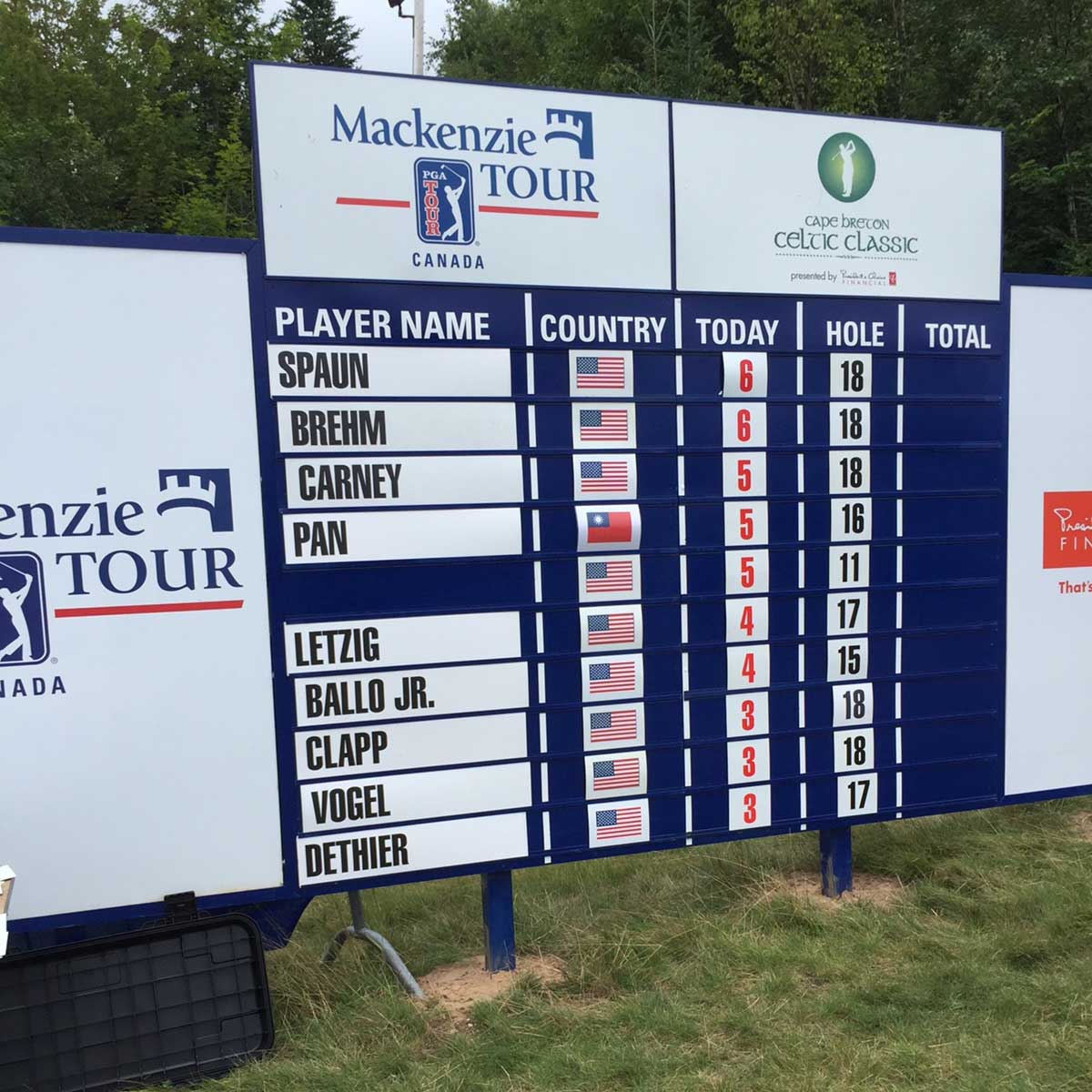
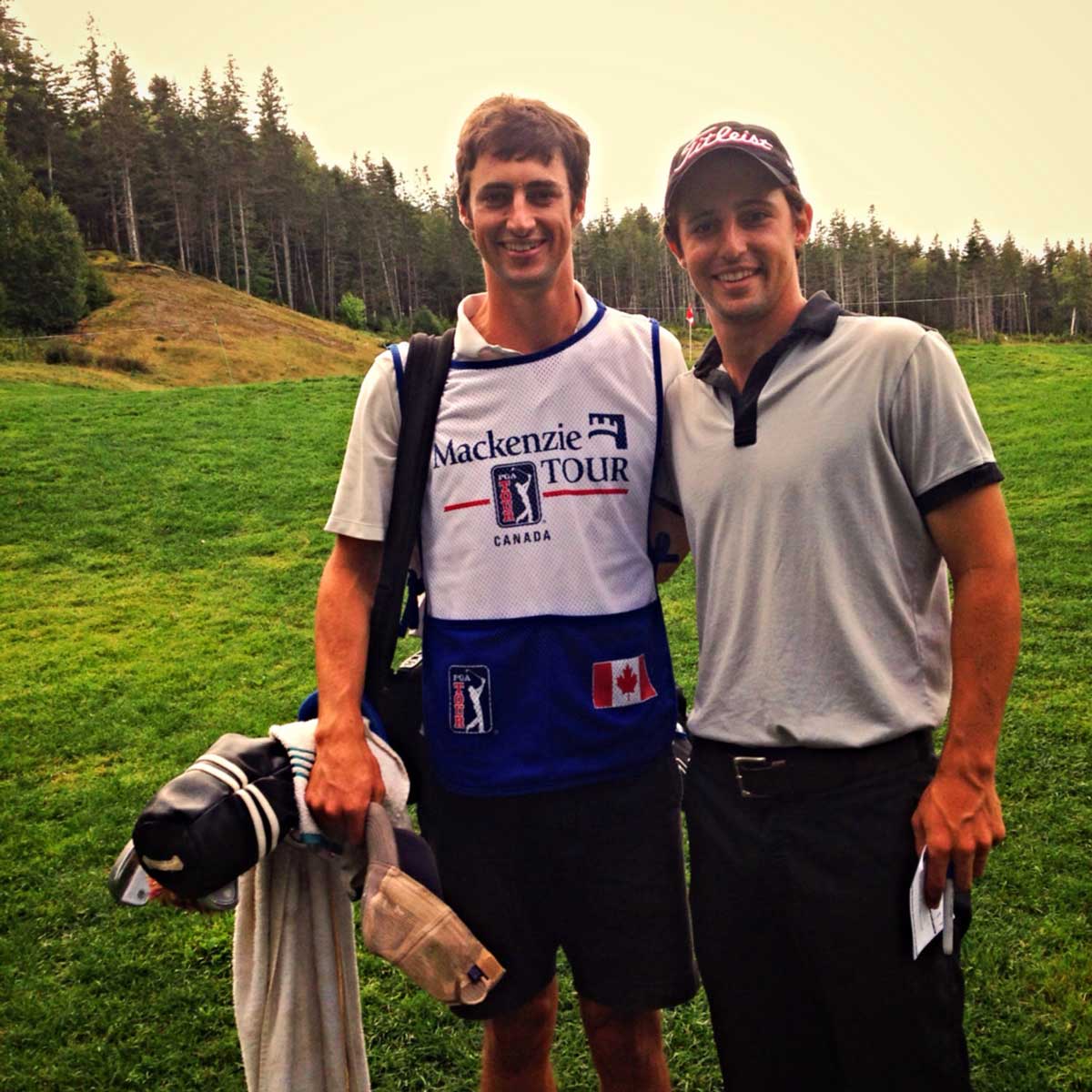
In the weeks prior, a three-putt from three feet would have unraveled me just like it has unraveled thousands of mini-tour players. Evan gave me a little punch to make sure I’d snapped back to the moment and handed me driver, an aggressive play on a short, tight, downhill par-4. I loved the mentality, and I loved his trust in me, and I shook out my shoulders and my head, thought carefully about the shot I wanted to hit and committed to a hard, free swing that sent the ball easily over the fairway bunker and scampered down near the green. It was evening now, and the wind had died, quieting and focusing my attention. A nifty chip led to a kick-in birdie, and I was back to six under, with room to breathe. Another aggressive driver play left me with another short birdie putt on my 16th hole, which I converted, and after a par on 17, one tee shot stood between me and the weekend.
All week in practice, the tee shot on 18 had been the hardest on the course. A hazard ran down the left side, and it took 260 yards to reach the left half of the fairway, which had felt like a big ask into a chilling two-club wind on Tuesday and Wednesday. Down the right side was a fairway bunker, weeds and out-of-bounds stakes. Again, Evan gave me a little punch and reminded me that there was no wind to worry about and that I’d been hitting my driver great. I’m still not sure exactly what it was that worked, but something did: I split the fairway and threw one more decent wedge shot toward the flag, stopping 15 feet from the hole.
This was a great end to a great day: I did my best to lag the putt to tap-in range and the ball dripped into the center of the cup, rounding out three birdies in my last four holes to blast past the cut line with rounds of 69-67, eight under, two shots out of the lead. I’d been close to crying on a golf course before, but it had never been out of joy. Now I was experiencing a moment so euphoric that I wanted to fill a lake with the feeling and jump in. I triple-checked before signing my card, and as I turned to join Ev at the car he pointed to my summer-long enemy, a leaderboard. My name was on it. Dethier, T4. Redemption.
I regressed big-time on Saturday with a five-over 77, and while a tidy 68 on Sunday felt like another big step forward, it barely got me inside the top 40, earned me just $770 Canadian and elevated me to a measly 169th on the money list. But even though I was frustrated to fall out of contention, in some ways the weekend didn’t matter. I’d proved to myself that I was good enough and tough enough to keep up with the best of these guys. Weeks earlier I had contemplated quitting. Now, for better or worse, I was reinvigorated by some good play in Nova Scotia. It became clear on my 17-hour drive home: I needed another shot.
****
MOVING TO FLORIDA THAT SECOND WINTER was like walking into a cave and hoping it’d turn into a tunnel. Cody had given up the chase at the end of the summer, and I no longer could claim any sort of innocence as a kid trying something for a year post-college. Now I was a professional golfer, and not a very good one at that, and I arrived at the Wanderers Club in Wellington to valet cars and wash golf carts in exchange for the opportunity to practice and play at the course, honing my craft so that I’d be more prepared the next time I was in contention. There was an element of irony in a young tour pro trying to forge a career from a place called the Wanderers Club.
I was hired to work in “outside operations,” which meant exactly what it sounded like. If it happened outside, we oversaw it. In truth, I genuinely enjoyed some of the work. At dawn, whoever arrived at work first would get the best task: a leisurely cart lap around the course, filling coolers with water, ice and apples. At dusk, when the wind had quieted and the valet lot had been emptied, one of us would circle the course again, locking gates and ensuring nobody was on the property. The serenity of these cruises bookended the day nicely, and I found it refreshing to be part of a team and to work in an atmosphere where my coworkers were on my side rather than trying to take my money. On good days some guests would even violate the no-tipping policy, getting me a little closer to paying that month’s rent.
As for my game, the chief revelation came in the form of a new coach.
“You know what the biggest problem with that shot was?” Michael Hebron asked. He said it in my direction, but he asked it of himself. Nobody ever knew the answers to his questions anyways. “Your biggest problem was that you’re human.” Hebron would perch on a chair behind the row of tee markers on the range and deliver a steady stream of aphorisms to his players, the Yoda amongst his golfing Jedi. I couldn’t afford his services, but since I spent a large chunk of my free time on the range, Hebron would stop by between lessons to test out some of his parables.
I learned all manner of things from him, most notably to focus on the process and not the outcome, and that the backswing is momentum and the downswing just gravity. He stayed away from value judgments, rarely categorizing something as worse or better, but instead praising change for its own sake. “Different?” he’d ask, knowing a shot had felt, sounded and flown better. The highest compliment one could receive was three big claps and a wry smile.
We spent one evening on the range trying to free up my swing through impact. Hebron suggested that I begin by throwing my club as far out onto the range as I could. I was taken aback, as it occurred to me that this might be conduct unbecoming of an employee. “How many times?” I asked.
“Well, you’ve got what, 14 clubs?” he replied. “Let’s start with those.”
Thus passed the time at the Wanderers Club, seeking incremental improvements while the days whirred by like thrown golf clubs, one by one by one. I played in a handful of mini-tour events and far more cash games, gradually building toward a more self-assured player. I didn’t break through with any wins, but my swing became more reliable and more repeatable, and my scores more consistent. I hit it a little shorter, but much straighter. None of it was new anymore, but none of it was any easier. It was time to figure out once and for all if I could make a career of this.
***
IN THE END, the mini-tour golfer chasing the dream battles three enemies: talent, money and time. Talent is the most important but also the simplest part of the equation. Anyone can find somewhere to practice, anyone can find a course to join, anyone can pick some tournaments to enter for competitive experience. But talent in golf is a funny mix of ability and consistency. Lots of guys can hit it 300 yards, pure a 6-iron and then roll in a 25-footer — but how often can you repeat the process, and when it goes bad, how bad does it go? Talent can be developed, I hoped, because my career depended on it. If you were the very best at every level, talent would take care of everything. But if you weren’t quite there, and most of us weren’t, things got more complex.
Money was a tricky path to negotiate, but plenty of guys found ways to sustain themselves, making enough to cover rent and entry fees while they hoped for the big break. Time is the biggest factor. Every pro has the fear that one day he’ll be the old guy hanging on too long, but the thought of giving up too soon is even scarier. The question of “How far can I make it?” butted heads more and more often with another: What am I missing out on, personally and professionally, by pursuing a career in golf? What will happen when I turn 33, have just one appreciable skill, and I want to get a real job? But the allure of the PGA Tour, of playing a game for millions of dollars in front of millions of viewers, of competing for a living, of having the dream never end, was so great that many of us could not stop battling against the triple terrors of talent and money and time, no matter how long the odds.
The 2016 season had neither broken me nor pushed me to the next level. I failed to qualify for another season in Canada, so I focused on the New England state opens and mixed in travel to Monday qualifiers for Web.com or PGA Tour events. There were noticeable changes in my game. The blowups that had sabotaged so many of my early professional rounds were less and less frequent, and I realized I’d stopped getting so nervous on the 1st tee: I’d acquired some of the competitive numbness of my flat-liner colleagues. I finished in the money more and more often and played the entire summer without shooting worse than 74. Still, I notably lacked the rounds that produced big checks, the ability to make birdies and then keep making them and post rounds of five, six, seven under par.
Losing money less quickly was nice, but it didn’t change the hard truth: To justify toiling on, I needed to get some sort of status. My college buddies were progressing in their careers in cities across the country; some were getting promoted while others had already moved on to another job. The idea of playing the Providence Open as a bona fide way to make money felt less and less appealing. As the summer wore on, I set my sights on Web.com Q school. This would be my final stand.
Q school consisted of four hurdles: pre-qualifying, first stage, second stage and final stage. My previous year’s PGA Tour Canada status exempted me through pre-qualifying, so in October I traveled to St. George, Utah, my first-stage site assignment. Each stage demanded relentless over spectacular; the goal was simply to survive. Just shy of 1,000 players ponied up the substantial entry fee (I signed up early for $4,500, while others who missed the deadline paid up to $6,000), and over the course of the fall the number would be pared to 45.
St. George was one of a dozen first-stage sites; 80 players were in the field, and the top 25 would move on. I was a week away from turning 25, still too young to rent a car for the week but also more than two years down my professional rabbit hole. The conditions at SunRiver Golf Club were perfect for golf. It was dry, warm, and calm, and everyone in the field could reach all of the par-5s in two. That meant one thing: This was going to be a shootout.
My week came down to one stretch of holes, as it always seemed to. Rounds of 67-70 put me at five under, and on Day 3 I picked up three early birdies to get to eight under, right near where I guessed the top 25 cut line would fall. There were three par-5s on the back nine; even at 570 yards, the field was playing these holes like par-4s, and I knew if I could finish the day around 10 or 11 under I’d be in great shape heading into the final round. I hit two good shots on the 12th hole, setting up a makeable eagle putt, but raced it six feet by. I missed the comebacker and walked away with what felt like a bogey.
I still don’t understand exactly what it is about a bad shot that infects the next one, but it remained my greatest weakness to the end. I needed someone to punch me in the arm after the three-putt, but I was my own caddie this week, and I let one bad shot turn into another, and another, and another: I short-sided myself on 13, hit a flop shot into the bunker and made double bogey, then repeated the same sequence on the next hole: blocked iron, overly ambitious chip, double bogey. I three-putted for par on 15, and by the time I bogeyed 16 I was in shock. I had slid to three under through 54 holes, and I knew I’d need a Hail Mary the next day to sneak into the top 25.
That evening, I had dinner with a couple of friends from the Northeast, Mike Miller and Pat Wilson. Mike was sitting pretty at 11 under. I’d made more birdies than he had over the first three days, but he was drumming me by eight strokes.
“How do you do that?” I asked him. “You’re relentless out there.”
Mike shrugged. He wasn’t sure how to explain his secret. “You just have to make the best game plan of any guy out there,” he said. “Then you execute it the best, and no matter what happens you stick to that plan.” He took a big bite of a breadstick. “And Olive Garden. Gotta have Olive Garden. Isn’t this place the best?” Mike wasn’t one to mess with a good thing. We had dined there, I remembered regrettably, three consecutive nights. When played at its highest level, golf is a simple game, and Mike made it look and sound easier than I did. That’s why he was moving on and I was on the verge of heading home.
A few holes into the final round it became clear I wasn’t going to shoot 60, and I played the rest of the way in a daze, trying to process what it meant that I wasn’t going to make it through to the next stage. Many others in the field were surely experiencing a similar existential crisis.
In the end, the big realization wasn’t that I’m not good enough. Because maybe I am. I could give it my all for 10 more years and not be good enough for nine of them and then suddenly I’d get the right thought or meet the right instructor or maybe not even change a thing but my game would just click and I’d catapult over that fine margin and go on a hot streak … and boom! In a few months I’d go from playing for hundreds of dollars to millions of them. No, the big revelation was that, more than talent or money, I was out of time. If golf wasn’t going to be my life, I was ready to jump into another field, one in which trying hard and succeeding might have a stronger correlation. I had won less than $10,000 in official prize money during my two-year odyssey. I didn’t have the will to spend more of my youth on a gamble that promised nothing.
My flight home from Q school left from Las Vegas. That seemed fitting, because tour golf is a 24-hour poker room. When do you stop buying back in? Most of us are going to go bust, but for those who keep investing in themselves there is the chance to win big. Plenty of James Hahns make it, after all. I just won’t be one of them. And that’s O.K. It’s time to walk away from the table, to give my seat to the next player.
The author (cautiously) welcomes your comments at dylan_dethier@golf.com.


